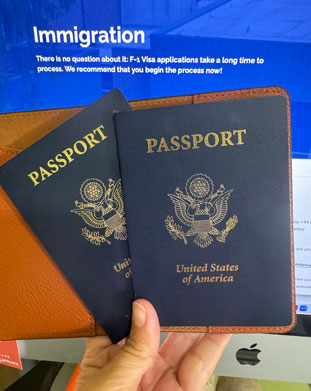Admitted Students
There is no question about it: F-1 Visa applications take a long time to process. We recommend that you begin the process now!

Immigration Information
International students studying in the United States will need several immigration documents, including a visa, I-94 card, passport, and an I-20 form. Immigration rules and regulations are covered in depth during orientation, but here are some key terms to help you get started:
- Review your I-20 form. Please make sure everything printed on it is accurate.
- Sign your I-20 form. On the first page at #11, you will need to print your name, sign, and put the date. If you are under 18 years old, your parent or guardian will also need to sign the I-20.
- Make a visa interview appointment with a United States embassy or consulate. Please visit US Travel Docs to access the nearest U.S. embassy or consulate’s website.
- You will also need to pay the I-901 SEVIS fee. Print your receipt to take to your visa interview and for your record. This fee must be paid at least three days before your visa interview. You will also be able to check the status of your payment from this website. We recommend that you pay online using a credit card as this is the fastest and easiest method.
- Please keep in touch between now and when you arrive at Cascadia and let us know if you have difficulties getting a visa interview appointment and/or getting a visa, if you get a student visa, or if you are unable to attend Cascadia College for the term you are accepted.
I-20 Form
Cascadia College issues an I-20 to students who are admitted to the college for full-time study. The I-20 is generally sent with along with your Cascadia acceptance letter, and allows you to apply for a visa and to enter or reenter the United States. You must have a valid, unexpired I-20 at all times. If your I-20 will expire before you finish your studies, apply for an extension before the expiration date.
F-1 Visa and F-1 Visa Status
A visa is a stamp that allows you to seek entry to the United States. As an international student, you will hold an F-1 visa. International students are usually admitted to the United States for the duration of status, meaning that you may stay in the United States as long as you are a full-time student. As long as you maintain your immigration status and have a valid I-20 form, you may stay in the United States, even if your F-1 visa expires while you are still studying. However, if you leave the U.S. with an expired visa and plan to re-enter, you must obtain a new F-1 visa from an embassy abroad before returning to the US.
When you enter the US on an F-1 visa, you have F-1 visa status. You must follow all regulations associated with your F-1 visa in order to maintain your immigration status. More details about maintaining your immigration status will be covered during orientation.
See more information about getting a U.S. visa.
SEVIS
SEVIS stands for Student and Exchange Visitor Information System and is a government database that collects and maintains information on F-1 international students. Schools enrolling F-1 students must update student information every quarter through the SEVIS database, and use this database to generate I-20s. The Department of Homeland Security, United States embassies and consulates, border officials, the Internal Revenue Service (IRS), the Social Security Administration, and international student advisors have access to the SEVIS system.